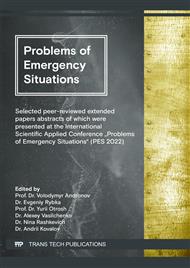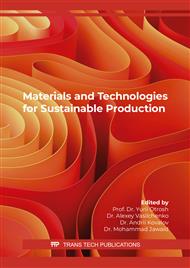[1]
V.V. Strelets, V.M. Loboichenko, N.A. Leonova, R.I. Shevchenko, V.M. Strelets, A.V. Pruskyi, O.V. Avramenko, Comparative assessment of environmental parameters of foaming agents based on synthetic hydrocarbon used for extinguishing the fires of oil and petroleum products, SOCAR Proceedings. Special Issue No. 2 (2021) 001–010.
DOI: 10.5510/ogp2021si200537
Google Scholar
[2]
Dadashov, V. Loboichenko, A. Kireev, Analysis of the ecological characteristics of environment friendly fire fighting chemicals used in extinguishing oil products. Pollution Research. 37(1) (2018) 63–77.
Google Scholar
[3]
T.S. Vovchuk, J.L. Wilk-Jakubowski, V.M. Telelim, V.M. Loboichenko, R.I. Shevchenko, O.S. Shevchenko, N.S. Tregub, Investigation of the use of the acoustic effect in extinguishing fires of oil and petroleum products, SOCAR Proceedings. Special Issue No. 2 (2021) 024–031.
DOI: 10.5510/ogp2021si200602
Google Scholar
[4]
A. Levterov, Acoustic research method for burning flammable substances, Acoustical Physics. 65(4) (2019) 444–449.
DOI: 10.1134/s1063771019040109
Google Scholar
[5]
K. Mygalenko, V. Nuyanzin, A. Zemlianskyi, A. Dominik, S. Pozdieiev, Development of the technique for restricting the propagation of fire in natural peat ecosystems, Eastern-European Journal of Enterprise Technologies. 1(10–91) (2018) 31–37.
DOI: 10.15587/1729-4061.2018.121727
Google Scholar
[6]
Y. Abramov, O. Basmanov, J. Salamov, A. Mikhayluk, O. Yashchenko, Developing a model of tank cooling by water jets from hydraulic monitors under conditions of fire, Eastern-Euroean Journal of Enterprise Technologies.1(10-97) (2019) 14–20.
DOI: 10.15587/1729-4061.2019.154669
Google Scholar
[7]
Semko, M. Beskrovnaya, S. Vinogradov, I. Hritsina, N. Yagudina, The usage of high speed impulse liquid jets for putting out gas blowouts, Journal of Theoretical and Applied Mechanics (Poland). 3 (2017) 655–664.
Google Scholar
[8]
Kovalov, Y. Otrosh, O. Ostroverkh, O. Hrushovinchuk, O. Savchenko, Fire resistance evaluation of reinforced concrete floors with fire-retardant coating by calculation and experimental method, E3S Web of Conferences. 60 (2018) 00003.
DOI: 10.1051/e3sconf/20186000003
Google Scholar
[9]
N. Rashkevich, R. Shevchenko, I. Khmyrov, A. Soshinskiy, Investigation of the influence of the physical properties of landfill soils on the stability of slopes in the context of solving civil security problems, Materials Science Forum. 1038 (2021) 407–416.
DOI: 10.4028/www.scientific.net/msf.1038.407
Google Scholar
[10]
V. Loboichenko, К. Zakomorna, O. Ilinskyi, N. Leonova, A. Malko, R. Shevchenko, Investigation of the Content of Heavy Metals in Water Sources of Kharkiv City, Ukraine, Current applied science and technology. 22(2) (2022) 1–14.
DOI: 10.55003/cast.2022.02.22.013
Google Scholar
[11]
V. Loboichenko, V. Strelec, The natural waters and aqueous solutions express-identification as element of determination of possible emergency situation, Water and Energy International. 61/RNI(9) (2018) 43–51.
Google Scholar
[12]
M. Divizinyuk, N. Kasatkina and B. Melnyk, The Use of Electrical Monitoring and Surveillance Systems to Prevent Emergencies of a Terrorist Nature (on the Example of Motor Vehicles), 2019 IEEE 20th International Conference on Computational Problems of Electrical Engineering (CPEE) (2019) 1– 4.
DOI: 10.1109/cpee47179.2019.8949101
Google Scholar
[13]
da Costa JP, The 2019 global pandemic and plastic pollution prevention measures: Playing catch-up, Sci Total Environ. 774 (2021) 145806.
DOI: 10.1016/j.scitotenv.2021.145806
Google Scholar
[14]
J. Ammendolia, J. Saturno, A.L. Brooks, S. Jacobs, J.R. Jambeck, An emerging source of plastic pollution: Environmental presence of plastic personal protective equipment (PPE) debris related to COVID-19 in a metropolitan city, Environ Pollut. 269 (2021) 116160.
DOI: 10.1016/j.envpol.2020.116160
Google Scholar
[15]
L. Patrício Silva, A. Tubić, M. Vujić, A.M.V.M. Soares, A.C. Duarte, D. Barcelò, T. Rocha-Santos, Implications of COVID-19 pandemic on environmental compartments: Is plastic pollution a major issue? Journal of Hazardous Materials Advances. 5 (2022) 100041.
DOI: 10.1016/j.hazadv.2021.100041
Google Scholar
[16]
M.S. Haque, S. Sharif, A. Masnoon, E. Rashid, SARS-CoV-2 pandemic-induced PPE and single-use plastic waste generation scenario, Waste Manag Res. 39 (1_suppl) (2021) 3–17.
DOI: 10.1177/0734242x20980828
Google Scholar
[17]
J.E. Celis, W. Espejo, E. Paredes-Osses, S. A. Contreras, G. Chiang, P. Bahamonde, Plastic residues produced with confirmatory testing for COVID-19: Classification, quantification, fate, and impacts on human health, Science of the Total Environment. 760 (2021) 144167.
DOI: 10.1016/j.scitotenv.2020.144167
Google Scholar
[18]
F.P. De Albuquerque, M. Dhadwal, W. Dastyar, S.M.M. Azizi, I. Karidio, H. Zaman, B.R. Dhar, Fate of disposable face masks in high-solids anaerobic digestion: Experimental observations and review of potential environmental implications, Case Studies in Chemical and Environmental Engineering. 3 (2021) 10008.
DOI: 10.1016/j.cscee.2021.100082
Google Scholar
[19]
M.B. Haddad, G.E. De-la-Torre, M.R. Abelouah, S. Hajji, A.A. Alla, Personal protective equipment (PPE) pollution associated with the COVID-19 pandemic along the coastline of Agadir, Morocco, Sci Total Environ. 798 (2021) 149282.
DOI: 10.1016/j.scitotenv.2021.149282
Google Scholar
[20]
Tadele Assefa Aragaw, Surgical face masks as a potential source for microplastic pollution in the COVID-19 scenario, Marine Pollution Bulletin. 159 (2020) 111517.
DOI: 10.1016/j.marpolbul.2020.111517
Google Scholar
[21]
R. Akhbarizadeh, S. Dobaradaran, I. Nabipour, M.Tangestani, D. Abedi, F. Javanfekr, F. Jeddi, A. Zendehboodi, Abandoned Covid-19 personal protective equipment along the Bushehr shores, the Persian Gulf: An emerging source of secondary microplastics in coastlines, Marine Pollution Bulletin. 168 (2021) 112386.
DOI: 10.1016/j.marpolbul.2021.112386
Google Scholar
[22]
M. Ardusso, A.D. Forero-López, N.S. Buzzi, C.V. Spetter, M.D. Fernández-Severini, COVID-19 pandemic repercussions on plastic and antiviral polymeric textile causing pollution on beaches and coasts of South America, Science of The Total Environment. 763 (2021) 144365.
DOI: 10.1016/j.scitotenv.2020.144365
Google Scholar
[23]
M.R.J. Rakib, G.E. De-la-Torre, C.I. Pizarro-Ortega, D.C. Dioses-Salinas, S. Al-Nahian, Personal protective equipment (PPE) pollution driven by the COVID-19 pandemic in Cox's Bazar, the longest natural beach in the world, Mar Pollut Bull. 169 (2021) 112497.
DOI: 10.1016/j.marpolbul.2021.112497
Google Scholar
[24]
T.A. Aragaw, G.E. De-la-Torre, A.A. Teshager, Personal protective equipment (PPE) pollution driven by the COVID-19 pandemic along the shoreline of Lake Tana, Bahir Dar, Ethiopia, Science of the Total Environment. 820 (2022) 153261.
DOI: 10.1016/j.scitotenv.2022.153261
Google Scholar
[25]
Pengfei Wu, Jiangpeng Li, Xiao Lu, Yuanyuan Tang, Zongwei Cai, Release of tens of thousands of microfibers from discarded face masks under simulated environmental conditions, Science of the Total Environment. 806 (Part 2) (2022) 150458.
DOI: 10.1016/j.scitotenv.2021.150458
Google Scholar
[26]
Jin Il Kwak, Youn-Joo An, Post COVID-19 pandemic: Biofragmentation and soil ecotoxicological effects of microplastics derived from face masks, Journal of Hazardous Materials. 416 (2021) 126169.
DOI: 10.1016/j.jhazmat.2021.126169
Google Scholar
[27]
K. Selvaranjan, S. Navaratnam, P. Rajeev, N. Ravintherakumaran, Environmental challenges induced by extensive use of face masks during COVID-19: A review and potential solutions, nvironmental Challenges. (2021). 3. 100039.
DOI: 10.1016/j.envc.2021.100039
Google Scholar
[28]
N.V. Rashkevich, V.M. Loboichenko, N.O. Leonova, The used means of personal protective equipment is a dangerous component of solid waste, Collection XIІІ International Scientific and Methodological Conference, 147 International Scientific Conference of the European Association for Security (EAS) «HUMAN SAFETY IN MODERN CONDITIONS» Kharkiv, Ukraine, December 2–3, (2021) 64-66 [in Ukrainian].
Google Scholar
[29]
A.L. Patrício Silva, J. C. Prata, A. C. Duarte, D. Barcelò, T. Rocha-Santos, An urgent call to think globally and act locally on landfill disposable plastics under and after covid-19 pandemic: Pollution prevention and technological (Bio) remediation solutions, Chemical Engineering Journal. 426 (2021) 131201.
DOI: 10.1016/j.cej.2021.131201
Google Scholar
[30]
S.S. Siwal, G. Chaudhary, A.K. Saini, et al, Key ingredients and recycling strategy of personal protective equipment (PPE): Towards sustainable solution for the COVID-19 like pandemics, J Environ Chem Eng. 9(5) (2021) 106284.
DOI: 10.1016/j.jece.2021.106284
Google Scholar
[31]
Kuan Shiong Khoo, Lih Yiing Ho, Hooi Ren Lim, Hui Yi Leong, Kit Wayne Chew, Plastic waste associated with the COVID-19 pandemic: Crisis or opportunity? Journal of Hazardous Materials. 417 (2021) 126108.
DOI: 10.1016/j.jhazmat.2021.126108
Google Scholar
[32]
Jun-Qi Zhang, Xiang Wang, Zhen-Yu Yin, Ningyu Yang, Static and dynamic behaviors of granular soil reinforced by disposable face-mask chips, Journal of Cleaner Production. 331 (2022) 129838.
DOI: 10.1016/j.jclepro.2021.129838
Google Scholar
[33]
Z. ur Rehman, U. Khalid, Reuse of COVID-19 face mask for the amelioration of mechanical properties of fat clay: A novel solution to an emerging waste problem, Science of the Total Environment. 794 (2021) 148746.
DOI: 10.1016/j.scitotenv.2021.148746
Google Scholar
[34]
V. Strelets, V. Loboichenko, N. Leonova, R. Shevchenko, V. Telelim, V. Strelets, O. Shevchenko, A. Burmenko, Analysis of the Influence of Anthropogenic Factors of the Urbanized Territory of Poltava Region (Ukraine) on the State of River Water, Ecological Engineering & Environmental Technology. 23(2) (2022) 185–192.
DOI: 10.12912/27197050/146019
Google Scholar
[35]
V.M. Loboichenko, N.O. Leonova, Regarding the study of the influence of the chemical composition of protective masks for medical and non-medical purposes on the environment, All-Ukrainian Scientific Conference Actual Problems of Chemistry: Research and Prospects, (April 15, 2021). Conference materials. Zhytomyr: Publisher OO Evenok, (2021) 31 [in Ukrainian].
Google Scholar
[36]
G. Kutralam-Muniasamy, F. Pérez-Guevara, V.C. Shruti, A critical synthesis of current peer-reviewed literature on the environmental and human health impacts of COVID-19 PPE litter: New findings and next steps, J Hazard Mater. 422 (2022) 126945.
DOI: 10.1016/j.jhazmat.2021.126945
Google Scholar
[37]
Methods of agrochemical certification of agricultural lands / Ed. S.M. Ryzhuk, M.V. Lisov, D.M. Bentsarovsky. Kiyiv, 2003. [in Ukrainian].
Google Scholar
[38]
M.Tüzen, Determination of heavy metals in soil, mushroom and plant samples by atomic absorption spectrometry, Microchemical Journal. 74(3) (2003) 289–297.
DOI: 10.1016/s0026-265x(03)00035-3
Google Scholar
[39]
Purwanto, C. Supriyanto, P. Samin, The Validation of Atomic Absorption Spectrometry (AAS) Method for the Determination of Cr, Cu and Pb, In Sri Jauhari SDwi Wahini Nurhayati, Dwi Wahini Nurhayati, & Tjipto Sujitno, BA. (Eds.). Proceedings of the Scientific Meeting and Presentation on Basic Research in Nuclear of the Science and Technology part II: Nuclear Chemistry and Process Technology. Indonesia: National Nuclear Energy Agency. (2007) 151–158.
Google Scholar
[40]
4.3 B: Atomic Absorption Spectroscopy (AAS). Online: https://chem.libretexts.org/Bookshelves/Inorganic_Chemistry/Map%3A_Inorganic_Chemistry_(Housecroft)/04%3A_Experimental_techniques/4.03%3A_Elemental_Analysis/4.3B%3A_Atomic_Absorption_Spectroscopy_(AAS).
DOI: 10.1021/ic50201a700
Google Scholar
[41]
P. Banerjee, B. Prasad, Determination of concentration of total sodium and potassium in surface and ground water using a flame photometer, Applied Water Science. 10 (2020) 113.
DOI: 10.1007/s13201-020-01188-1
Google Scholar
[42]
Drozd, N. Leonova, Spectrophotometric Determination of Ni2+, Co3+, Fe2+, Cu2+ Concentrations with 1-(2-Pyridylazo)-2-Naphthol in Aqueous-Micellar Medium Based on two Intensive Parameters, Chemistry & Chemical Technology. 8(2) (2014) 129–134.
DOI: 10.23939/chcht08.02.129
Google Scholar
[43]
A.V. Drozd, V.M. Loboichenko, T.S. Tishakova, Spectrophotometric determination of iodides by the products of fluorescein halogenation using electrochemical oxidation, Journal of Analytical Chemistry. 66 (2011) 131–134.
DOI: 10.1134/s1061934811020055
Google Scholar



